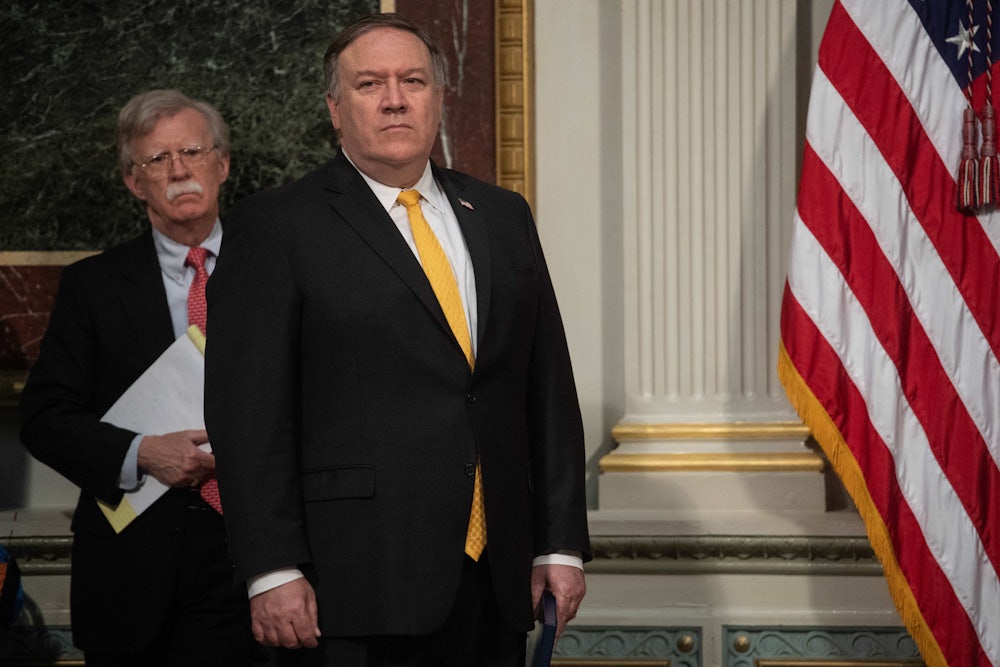The United States appears to be fast entering a war footing with Iran—blaming the country for an attack on two tankers in the Gulf of Oman last week, accusing it of testing the limits of their now-dead nuclear accord with the U.S., sending 1,000 extra troops to the Middle East, and reportedly considering “tactical” strikes. This is alarming enough, but these moves also raise an unusual question: Who, exactly, is telling the U.S. military what to do here?
The ostensible civilian commander of military forces is the secretary of defense. Patrick Shanahan, a former Boeing executive, was named in January as James Mattis’s replacement for that position, but still has not been officially nominated to the post—and he is, according to five current and former coworkers who spoke to Politico last week, “too easily manipulated by an unpredictable White House.” On Shanahan’s watch, these coworkers say, staffers for national security advisor and notorious Iran hawk John Bolton are regularly “calling Pentagon underlings and inserting themselves deep into the chain of command.” Shanahan, according to these accounts, is still auditioning for his job, and consequently is “outgunned by others in Trump’s orbit.” (Later on Tuesday, Trump announced that Shanahan had withdrawn from consideration for the position.)
Then came the news Monday that Secretary of State Mike Pompeo—the conservative former congressman and CIA chief, who was the first U.S. official out of the gate to accuse Iran of orchestrating the Oman attacks—was traveling to the Tampa headquarters of the U.S. Central Command (CENTCOM) and Special Operations Command (SOCOM) to meet with command leadership and “discuss regional security concerns and ongoing operations.” CENTCOM is responsible for military operations in the Middle East and would carry out any strikes against Iran. Multiple sources at the Department of Defense (DOD) and State Department tell me that Pompeo was not traveling to Tampa with any Pentagon representatives; the Pentagon said that Shanahan had no plans to join Pompeo there.
This is truly without precedent. When I asked State Department officials for any similar past trips by other secretaries of state, they provided none. I found one occasion when Secretary Condoleezza Rice visited the Tampa base in 2006—accompanying the commander-in-chief, George W. Bush—to greet Afghan and Pakistan leaders for a state summit. Secretary Hillary Clinton also visited the base, also not for operational reasons, to deliver a dinner address to a Special Operations Command gala in 2012.
Neither of those visits came close to what appears to be the case this week: The United States’ top diplomatic officer, who is not in the military’s chain of civilian command, is traveling to a war headquarters to discuss prospects for military action with the generals there. He will not be without Pentagon minders at CENTCOM in Shanahan’s absence, State Department sources tell me, but if proximity is power, there’s a clear suggestion that Pompeo and Bolton are acting as primary movers behind military plans for Iran.
Such concerns are “bunk,” according to a senior administration official who spoke to me on background: “The visit was scheduled several weeks ago, and fully coordinated with Acting Secretary Shanahan.” CENTCOM’s and SOCOM’s commanders, the official said, “are briefing Secretary Pompeo, and the Secretary is there to listen. Top officials from the Pentagon are also in attendance.”
To be sure, CENTCOM’s recently minted commander, Marine General Kenneth McKenzie, has a wealth of experience and knowledge of Middle East players, and he may have much to tell Pompeo. In one of McKenzie’s first public speeches as CENTCOM chief, delivered last month to the hawkish Foundation for Defense of Democracies, he expressed a curious skepticism of DOD bureaucracy. “I’ve always tried to have a bias for action,” he told the audience, adding that in considering action, “we don’t have the luxury any longer of stovepipe ownership of strategic assets.” Where would such streamlined action and assets likely be needed? On this point, McKenzie was clear: “The long-term, enduring, most significant threat to stability in the Central Command [area of responsibility] is Iran, and the Iranian regime’s malign ambitions across the theater and, indeed, globally.”
The health and stability of American constitutional democracy relies in no small part on civilian control of the U.S. military establishment. But it has always specified which few civilians are responsible for that control, and how they are to carry out their duties. Since the 1947 National Security Act, those civilians have been the president and the secretary of defense.
When the second Bush administration cooked up a case and a plan for war with Iraq, much of the cooking was done within the Pentagon, under the eye of Secretary Donald Rumsfeld; the results of that short-circuiting were bad enough. But we now have entered a phase in which the president is not talking, the secretary of defense is not working, and many of their responsibilities appear to be taken up by hawkish unelected principals in the Department of State and the National Security Council.
Last April, Pompeo and Bolton successfully overruled Pentagon concerns in getting Iran’s Islamic Revolutionary Guard Council designated as a terrorist organization. Now, using U.S. Navy surveillance video, they openly blame elements of the Islamic Revolutionary Guard Corps for last week’s Oman attack, as they insert themselves into military deliberations. It’s easy to see the trajectory on which they’re putting the U.S. military. The impact this will have on the bedrock principles of democratic U.S. governance is much more insidious.
